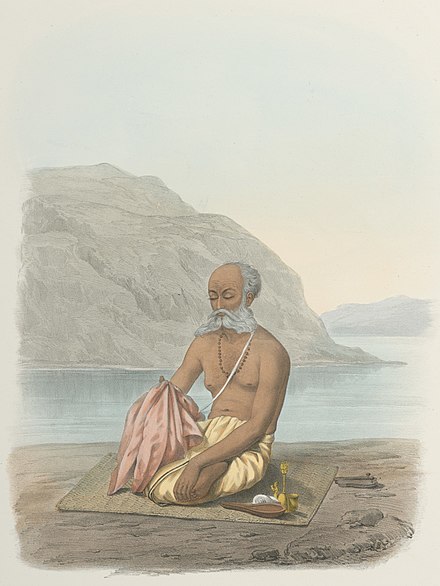The Gayatri Mantra is also known as Sāvitri Mantra. It is originally mentioned in Rig Veda (Mandala 3.62.10) in dedication to the Vedic sun deity Savitr.
What is a mantra?
The Sanskrit word mantra combines the verb root of “think” (man) with a term for “instrument” (tra). Thus, a mantra is a tool for controlling the mind. In Patanjali’s Yoga Sutra, it is mentioned that mantras are important for controlling the mind and quieting it down. They help in achieving concentration.
In Tantric schools of thought, they are used in rituals to channel energies of gods within the body.
The Mantra

Translation: “Let us meditate on Isvara and His Glory who has created the Universe, who is fit to be worshipped, who is the remover of all sins and ignorance. May he enlighten our intellect” [1].

Gayatri Mantra Syllables
Gayatri mantra is made up of 24 syllables.
| No | Syllable |
| 1 | tat |
| 2 | sa |
| 3 | vi |
| 4 | tur |
| 5 | va |
| 6 | re |
| 7 | ni |
| 8 | yam |
| 9 | bhar |
| 10 | go |
| 11 | de |
| 12 | va |
| 13 | sya |
| 14 | dhī |
| 15 | ma |
| 16 | hi |
| 17 | dhi |
| 18 | yo |
| 19 | jo |
| 20 | naḥ |
| 21 | pra |
| 22 | cho |
| 23 | da |
| 24 | yāt |
Gayatri Mantra Meaning
In our everyday life, we live in such a way that we identify with the body and we mistake the body to be the soul (Deha-Atmabuddhi). Gayatri mantra is chanted so that this no longer remains the case. It is a prayer to the Mother of the Vedas, Gayatri, to bestow on us Suddha-Sattva-Buddhi, i.e., knowledge of the soul [1].
The Advaitic meaning of Gayatri is “Aham Brahma Asmi” (I am Brahman) [1].
In Gayatri Mantra there are 9 names that are used to describe god. These names are following the sequence in Fig. 1: 1. Om, 2. Bhuh, 3. Bhuvah, 4. Svah, 5. Tat, 6. Savituh, 7. Varenyam, 8. Bhargah and 9. Devasya.

While pronouncing the Gayatri mantra there are five places where one has to take a pause:
- ‘Om’ is the first stop
- ‘Bhur Bhuvah Svah’ the second
- ‘Tat Savitur Varenyam’ the third
- ‘Bhargo Devasya Dheemahi’ the fourth
- ‘Dhiyo Yo Nah Prachodayat’ the fifth
The main deity of Gayatri Mantra is Savitr, a Vedic sun deity. The Mantra is said to be composed by Rishi Visvamitra. Gayatri is the meter of the mantra.
Gayatri mantra is usually recited during a sacred thread ceremony called Upanayanam for boys in the Brahmin community. It is also recited during Pranayama and Japa sessions.
Gayatri mantra can be repeated mentally while a person is lying, sitting, or even walking. According to Swami Sivananda, this mantra can be performed by any person without initiation also. It can be commonly prescribed for all the Hindus (outside of sectarian concerns, it can be performed by any person since it is considered a mantra that balances all Doshas equally).
"Verily, man is Yajna (sacrifice). The first twenty-four years of his life constitute the morning ritual, for the Gayatri includes 24 letters and it is the Gayatri through which the morning ritual is performed." – Chhandogya Upanishad (Chap. III, Sec. XVI).
Benefits of Gayatri Mantra Japa
- Gayatri is considered as the mother of Vedas and eradicator of all sins. It is considered as a wholly purifying mantra. The Japa of Gayatri is believed to provide the same fruits as the recitation of all the four Vedas and their Angas.
- Reciting this mantra three time a day – morning, afternoon and evening– has the potential to bring Moksha.
- It improves the health and strength of a person.
- It helps in bringing about a magnetic aura around the face.
- It helps in increasing the energy and vitality of a person.
- It destroys the three kinds of Taapa or pain (adhyatmik – spiritual, adhidevik – environmental and adhibhautik – physical).
- It destroys the three Granthis or knots of ignorance: Avidya, Kama and Karma [1].
- It strengthens and purifies the mind; a person can become highly intelligent by regularly reciting this mantra.
- Gayatri Japa can lead to the realization of the Advaitic Brahman or Unity of Consciousness
Praise of Gayatri Mantra in Scriptures
- “Among the Srutis that can be sung, I am the hymns in the Sama Veda known as Brhatsama; while among the Vedic hymns, I am the hymn known as Gayatri. No mantras in the world is comparable with Gayatri Mantra.” – Bhagavad Geeta (BG 10th chapter 35th verse)
- “Verily, all this creation is Gayatri. Speech is Gayatri; by speech is all this creation preserved. The Gayatri is verily composed of four feet, and possesseth six characteristics. The creations constitute the glories of Gayatri. The Brahman, i.e., the being indicated in the Gayatri, is verily the space which surroundeth man. This space is the same as the one within man” – Chhandogya Upanishad (Chap. III, Sec. XII)
Even Buddha has sung praise for this Mantra in the scripture Majjhima Nikaya, verse 92:
"The foremost of sacrifices is offering to the sacred flame; the Sāvittī is the foremost of poetic meters; of humans, the king is the foremost; the ocean’s the foremost of rivers; the foremost of stars is the moon; the sun is the foremost of lights; for those who sacrifice seeking merit, the Saṅgha is the foremost" [2].
References
- Book: Japa Yoga – A Comprehensive Treatise on Mantra-Sastra by Swami Sivananda
- Book: Majjhima Nikaya translated by Bhikkhu Sujat by Bikkhu, Sujato
- Book: Chandyoga Upanishad
- Book: Srimad Bhagwad Gita in Sanskrit, Hindi & English by Geeta Press

i have been practicing japa for the past year. this article has helped me clarify my doubts. thank you! well d0ne!